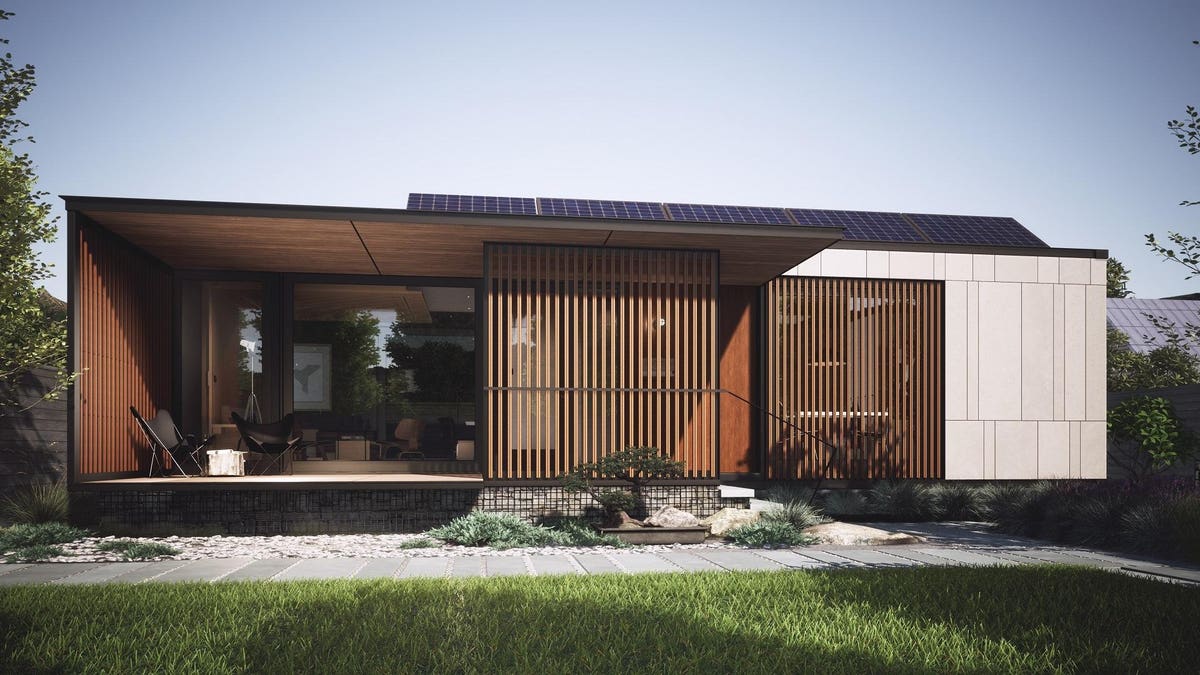With America facing a shortfall of 7.3 million affordable housing units across the nation, there’s a desperate need to use innovation to help fill the gap.
ZenniHome is looking to answer that call. Based in Page, Arizona, the startup was co-founded in 2019 by Bob Worsley, a manufacturing expert, author, serial entrepreneur and former state senator best known for founding SkyMall, and Stephen James, a designer and architect who previously specialized in master planned communities. The two saw opportunities in modular designs and centralized and automated factory construction, but also wanted to use technology to address the livability concerns for smaller housing units. With 40,000 soft orders in hand before they’ve even officially launched, they must be onto something. Privately funded thus far, the company has launched a crowdfunding campaign to help finance its next stage of growth.
“We decided to open up crowdfunding as a way to invest in ZenniHome because we believe in the power of community,” Worsley said. “We’re not just building homes–we’re building a movement. By allowing the public to invest in our company, we’re giving everyone the opportunity to be a part of this housing revolution. We see our investors not just as financial contributors, but as partners in our mission to bring affordable, innovative housing to millions of Americans.”
The co-founders started out by considering the various design options that could fulfill their vision. They eventually chose to standardize with two product offerings based on the dimensions of 20-foot and 40-foot shipping containers to facilitate transportation from the factory to the job site. But they added an extra two and a half feet to the typical container height for better livability. The smaller Denizen model features 320 square feet of living space and starts at $90,000, while the larger Citizen model measures 640 square feet and starts at $125,000. Each also sports additional porch and deck space.
To make the small home “live larger,” the designs feature automation and robotics to configure the interior spaces for different uses. Beds automatically lift out of the way to the ceiling, and walk-in closets slide against the walls when not in use. Each model also comes completely equipped with appliances and furniture.
What’s more, the standardized modules are designed to stack together, so that larger homes can be built from those base modules. Designed to stack up to five high, the modules can also be incorporated into larger multifamily dwellings.
The focus now is on scaling up the existing factory in Page, Arizona, to deliver the company’s initial 1,000-home objective. While the company is already producing its first units at the site, ZenniHome has completed the design for a full-scale factory, employing digital twin technology to help ensure the design will deliver on its promised throughput once the plant is completed. Eventually that fully scaled robotics-driven facility will serve as a model for three additional manufacturing plants, one in each of the other three quadrants of the country.
“I think the timing is right,” said Tom Hardiman, Executive Director of both the Modular Home Builders Association, which focuses on domestic single-family home building, and the Modular Building Institute, which focuses on international builders of multi-family dwellings. “Every state, city, and jurisdiction we talk to has a housing problem. That coupled with the labor shortage has really fired up the modular business. Our market share has doubled, and almost tripled, in the past five years. It’s not huge–about 6% share now–but it’s growing fast.”
The ZenniHome founders take pride in their original factory occupying the space left on Navajo Nation land when the coal-fired Navajo Generating Station was shut down and demolished in 2020. The company just signed a lease extension for the use of the site for up to 75 more years.
“Our partnership with the Navajo Nation is a cornerstone of our mission at ZenniHome,” explained Worsley. “We’re deeply honored to be a part of President Nygren’s 1,000-home initiative. This is not just about building homes, but about addressing the housing crisis on Navajo Nation land. We’re committed to bringing good jobs back to the community and utilizing the skilled workforce to help make the area a new manufacturing powerhouse. Together, we’re not just solving a housing crisis, we’re creating a brighter future for the Navajo Nation.”
ZenniHome has completed prototypes of each of its models available to tour in Mesa, Arizona. The company also recently broke ground with a development partner who invested in the seed round in 2022 on a 90-unit, 75-foot-tall apartment for rent project. The models and the new midrise are only two blocks apart for visitors who want to see ZenniHome’s first products firsthand.
Hardiman sees tremendous potential for the company. “I think there is a lot more predictability with this process–they can shorten the production schedule and be more likely to deliver houses on time and within budget,” he said. “Modular construction is already more efficient than site-built, and we really haven’t tried that hard yet. Once technology takes root in modular building, it’s going to explode. With this embrace of factory automation, labor productivity and construction efficiency will grow exponentially.”
Worsley sees the company’s unique mix of automation in both its factory and its finished product as a core element of how technology can help solve today’s societal problems. “At ZenniHome, we’re not just at the forefront of a housing revolution, we’re the catalyst,” he said. “Our mission goes beyond creating affordable, innovative homes. We’re building a future where everyone has access to sustainable, livable spaces. The immense growth potential of ZenniHome is not just about expanding our business, but about making a tangible, positive impact on the housing landscape. This is more than a business strategy, it’s a commitment to a better future. We’re excited about our journey and invite everyone to join us as we redefine the future of housing.”
Read the full article here





